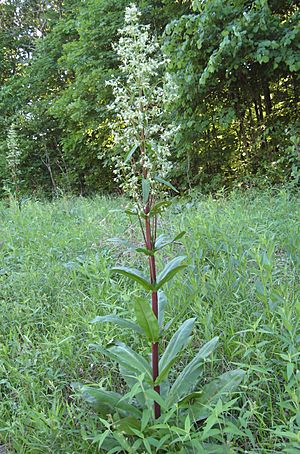American columbo facts for kids
Quick facts for kids American columbo |
|
|---|---|
 |
|
| Scientific classification | |
| Genus: |
Frasera
|
| Species: |
caroliniensis
|
| Synonyms | |
|
Swertia caroliniensis (Walter) Kuntze |
|
Frasera caroliniensis, also known as American columbo or yellow gentian, is a tall plant from the gentian family. You can find it growing in the forests of Southern Ontario in Canada, and across the eastern and southeastern parts of the United States. This plant used to be called Swertia caroliniensis.
Contents
About American Columbo
American columbo is a special type of plant called a monocarpic perennial. This means it grows for many years, sometimes up to 30 years, but it only flowers once in its lifetime. After it flowers and produces seeds, the plant dies.
When it's ready to flower, the plant grows a tall, round stem. Leaves, usually in groups of four, grow on this stem. These leaves are long and narrow, about 3 to 6 inches (7.5 to 15 cm) long.
The plant produces many flowers, often 50 to 100 of them. These flowers grow in a cluster called a panicle. Each flower is about 1 inch (2.5 cm) wide. They are green to yellow with small purple spots. Soon after the flowers bloom, they turn into fruits.
The whole plant can grow very tall, sometimes over 6.5 feet (2 meters)! The seeds are inside a brownish, oblong-shaped capsule, about 1/2 inch (1.2 cm) long.
The roots of American columbo are thick and fleshy. They grow straight down into the ground, like a carrot. This type of root system is called a taproot. The leaves of the plant feel thick and waxy. They grow on small stalks.
Other Names for the Plant
This plant has many different common names! Some of them include:
- American calumba
- American colombo
- Radix colombo americanae
- Frasera Walteri
- Frasera Canadensis
- Faux colomo
- Meadowpride
- Pyramid-flower
- Pyramid-plant
- Indian lettuce
- Yellow gentian
- Ground-century
Where It Lives
American columbo likes to grow in dry, high areas. You can often find it in rocky woods. It prefers soil that contains lime, but it can grow in different types of soil too.
This plant grows in many places. It is found in the forests of southern Ontario, Canada. In the United States, it lives in southern Michigan, northern Indiana, southern Illinois, southern Missouri, southeast Oklahoma, southwestern Arkansas, and northern Louisiana.
How People Used It
In the early 1800s, people thought the root of American columbo had medicinal uses. They believed it could help with different illnesses. For example, some thought it could be used on the skin for certain conditions. Others claimed it helped with problems like jaundice or scurvy.
The dried root of the plant was even listed in the United States Pharmacopoeia, a book of medicines, from 1820 to 1880. It was used as a simple tonic. A tonic is something that makes you feel stronger or healthier.
Sometimes, American columbo was used as a substitute for another plant called Calumba root. Calumba root comes from Mozambique.
Plant Neighbors
American columbo grows alongside many other plants. Several types of trees are often found near it. These include sweet-gum (Liquidambar styraciflua), tulip tree (Liriodendron tulipifera), and pignut hickory (Carya glabra).
Many smaller plants and vines also share its habitat. Some examples are eastern redbud (Cercis canadensis), strawberry bush (Euonymus americanus), Japanese honeysuckle (Lonicera japonica), Virginia creeper (Parthenocissus quinquefolia), and poison ivy (Toxicodendron radicans).
Other herbs that grow with it include prostrate ticktrefoil (Desmodium rotundifolium), Christmas fern (Polystichum acrostichoides), and ebony spleenwort (Asplenium platyneuron).
The tall trees that grow above American columbo are very important for its survival. They create a canopy that provides shade. If the canopy becomes too thick, the plant might not flower as well. When the plants do flower, they have large nectaries. These produce a sweet liquid called nectar, which helps attract insects for pollination.
Protecting American Columbo
American columbo is an endangered plant in Ontario, Canada. It is also considered endangered across Canada. One of the biggest threats to this plant is invasive plants. These are plants that are not native to the area and grow very quickly, taking over the habitat.
Because American columbo lives for a long time before flowering, it has trouble adapting to fast changes in its environment. This means it might not survive long enough to spread its seeds. Also, its seeds have a "seed dormancy." This means they won't sprout until the perfect spring conditions are present.
Deforestation, which is when forests are cut down, is also very harmful to these plants. They depend on the shade and protection provided by the tree canopy.
To help protect American columbo, people are working on different conservation methods. These include leaving surrounding trees within 4 square meters (about 43 square feet) of the plant. They also try to encourage growth by making small openings in the tree canopy. Draining areas that are too wet can also help, as the plant prefers clay-like soil.

